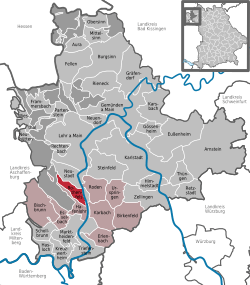Rothenfels
| Rothenfels | ||
|---|---|---|
| ||
 Rothenfels | ||
Location of Rothenfels within Main-Spessart district  | ||
| Coordinates: 49°53′N 9°35′E / 49.883°N 9.583°ECoordinates: 49°53′N 9°35′E / 49.883°N 9.583°E | ||
| Country | Germany | |
| State | Bavaria | |
| Admin. region | Unterfranken | |
| District | Main-Spessart | |
| Municipal assoc. | Marktheidenfeld | |
| Government | ||
| • Mayor | Michael Gram | |
| Area | ||
| • Total | 12.07 km2 (4.66 sq mi) | |
| Population (2015-12-31)[1] | ||
| • Total | 1,004 | |
| • Density | 83/km2 (220/sq mi) | |
| Time zone | CET/CEST (UTC+1/+2) | |
| Postal codes | 97851 | |
| Dialling codes | 09393 | |
| Vehicle registration | MSP | |
| Website | www.rothenfels.de | |
Rothenfels is a town in the Main-Spessart district in the Regierungsbezirk of Lower Franconia (Unterfranken) in Bavaria, Germany and a member of the Verwaltungsgemeinschaft (Administrative Community) of Marktheidenfeld. It is said to be Bavaria’s smallest town.
Geography
Location
Rothenfels lies on the Main’s right bank between Lohr and Marktheidenfeld, 5 km north of Marktheidenfeld, and 33 km east of Aschaffenburg. Squeezed as it is between the river and a bluff, the town consists of little more than a main street. Since 2006, the Maindamm, previously part of the railway line Lohr-Wertheim has been used as a town bypass.
Neighbouring communities
From the north, clockwise: Neustadt am Main, Marktheidenfeld, Hafenlohr, Fürstlich Löwensteinscher Park (gemeindefreies Gebiet).
Subdivisions
Rothenfels has two Stadtteile, Rothenfels in the valley of the Main and Bergrothenfels on the hill, next to Rothenfels Castle (Burg Rothenfels).
History
The settlement, which arose under Rothenfels Castle’s protection about 1148, had its first documentary mention as a town in a document from Prince-Bishop of Mainz von Wolfskehl. During German Mediatisation in 1803, the now Würzburg-ruled Rothenfels passed to the princely house of Löwenstein-Wertheim-Rosenberg, and then in 1806 to the Principality of Aschaffenburg; in 1813, Rothenfels became part of the Kingdom of Bavaria.
Bergrothenfels was separated administratively from Rothenfels in the 19th century, only to be reamalgamated in the 1971 Gebietsreform.
Government
The mayor of Rothenfels is Michael Gram.
Coat of arms
The town’s arms might be described thus: Or in base water argent, issuant therefrom three crags gules, in chief the letter R of the same.
The town’s oldest known seal, carved in the late 16th century and known from a 1619 imprint, only showed the uppercase R. The same image is shown in a roll of arms from 1544, wherein the R is shown in red on a silver field. Shown on town and council seals from 1710 is a castle on crags, which are surmounted by the uppercase R (that is, the R is on the crags, not over them), possibly canting for the town’s name, which means “Stronghold in Red Bunter”. Since the early 19th century, all examples of the town’s seal show the current composition. The arms were affirmed in 1836.[2]
Attractions
Aside from its late-16th century town hall, the town features some historic timber-frame houses.
On the hill above the town stands Rothenfels Castle (Burg Rothenfels). Rothenfels Castle is associated with the Catholic youth movement "Quickborn" (named after Quickborn in Schleswig-Holstein), and serves as a Christian education and conference centre. The castle is also a German Youth Hostel Association (DJH) youth hostel.
Images
 Main street
Main street Church
Church Rothenfels Castle
Rothenfels Castle
References
External links
| Wikimedia Commons has media related to Rothenfels. |
- Town’s official webpage (German)
- Rothenfels Castle (German)
